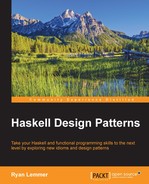The map function is a specialization of fold since we can write map in terms of fold:
map f = foldr ((:).f) []
Just as with fold, we can map over lists with regular or monadic functions:
doF n = do print n; return (n * 2)
main = do
print $ map (* 2) [2, 3, 5, 7]
mapM doF [2, 3, 5, 7] >>= print
mapM_ doF [2, 3, 5, 7]The type signatures are very informative:
map :: (a -> b) -> [a] -> [b] mapM :: (a -> m b) -> [a] -> m [b] mapM_ :: (a -> m b) -> [a] -> m ()
In Chapter 3, Patterns of Composition, we wrote mapM in terms of sequence and sequenceA (the Monad and Applicative forms respectively). When we use sequenceA, we get a function that maps over Applicative:
mapA :: Applicative f => (a -> f t) -> [a] -> f [t] mapA f = sequenceA' . (map f) sequenceA' :: Applicative f => [f t] -> f [t] sequenceA' [] = pure [] sequenceA' (x:xs) = (:) <$> x <*> (sequenceA' xs) -- import Control.Applicative main = mapA doF [2, 3, 5, 7] >>= print
This evaluates as:
sequenceA' . (map doF) [2, 3, 5, 7] (:) <$> (doF 2) <*> sequenceA' . (map doF) [3, 5, 7] (4:) (:) <$> (doF 3) <*> sequenceA' . (map doF) [5, 7] ... (4:6:10:14:[])
Even though evaluation is lazy, each list element is being visited twice:
- The
mapAinstance traverses the list and appliesfto each traversed list element sequenceAperforms the resulting actions and re-assembles the results as a list
However, if we define mapA in the following way, we will have a single traversal:
mapA' f [] = pure [] mapA' f (x:xs) = (:) <$> f x <*> (mapA' f xs) main = mapA' doF [2, 3, 5, 7] >>= print
Given mapA, we can define sequenceA in terms of it:
sequenceA = mapA id
This means that mapA and sequenceA can be defined interdependently:
mapA f = sequenceA . (map f) sequenceA = mapA id
Applicative the map and
sequence method are at the heart of the Traversable type-class.
As with the Prelude.foldM, mapM fails us beyond lists, for example, we cannot mapM over our Tree from earlier:
main = mapM doF aTree >>= print
-- INVALIDThe Traversable type-class relates to map in the same manner as Foldable relates to fold:
-- required: traverse or sequenceA class (Functor t, Foldable t) => Traversable (t :: * -> *) where -- APPLICATIVE form traverse :: Applicative f => (a -> f b) -> t a -> f (t b) sequenceA :: Applicative f => t (f a) -> f (t a) -- MONADIC form (redundant) mapM :: Monad m => (a -> m b) -> t a -> m (t b) sequence :: Monad m => t (m a) -> m (t a)
The traverse function generalizes our mapA function, which was written for lists, to all Traversable containers. Similarly, Traversable.mapM is a more general version of Prelude.mapM for lists:
mapM :: Monad m => (a -> m b) -> [a] -> m [b] mapM :: Monad m => (a -> m b) -> t a -> m (t b)
The Traversable type-class was introduced along with Applicative:
Let's make our
Tree an instance of Traversable; we'll start with the difficult way:
instance Functor Tree where
fmap f (Leaf x) = Leaf (f x)
fmap f (Node x lTree rTree)
= (Node (f x)
(fmap f lTree)
(fmap f rTree))
instance Foldable Tree where
foldMap f (Leaf x) = f x
foldMap f (Node x lTree rTree)
= (foldMap f lTree)
'mappend' (f x)
'mappend' (foldMap f rTree)
-- traverse :: Applicative ma => (a > ma b) > mt a > ma (mt b)
instance Traversable Tree where
traverse g (Leaf x) = Leaf <$> (g x)
traverse g (Node x ltree rtree)
= Node <$> (g x)
<*> (traverse g ltree) <*> (traverse g rtree)
data Tree a = Node a (Tree a) (Tree a)
| Leaf a
deriving Show
aTree = Node' 2 (Leaf' 3)
(Node' 5 (Leaf' 7)
(Leaf' 11))
-- import Data.Traversable
main = traverse doF aTree
where doF n = do print n; return (n * 2)An easier way to do this would be to autoimplement Functor, Foldable and Traversable! (We will see how this magic is done in Chapter 6, Patterns of Generic Programming):
{-# LANGUAGE DeriveFunctor #-}
{-# LANGUAGE DeriveFoldable #-}
{-# LANGUAGE DeriveTraversable #-}
import Data.Traversable
data Tree a = Node a (Tree a) (Tree a)| Leaf a
deriving (Show, Functor, Foldable, Traversable)
aTree = Node' 2 (Leaf' 3)
(Node' 5 (Leaf' 7)
(Leaf' 11))
main = traverse doF aTree
where doF n = do print n; return (n * 2)The "Gang of Four" Iterator pattern is concerned with providing a way
"To access the elements of an aggregate object sequentially without exposing its underlying representation" | ||
| --Gamma et al, "Gang of Four" Design Patterns, 1995 | ||
In The Essence of the Iterator Pattern, Jeremy Gibbons shows precisely how the Applicative traversal captures the Iterator pattern.
The Traversable.traverse function is the Applicative version of Traversable.mapM, which means that it is more general than mapM (because Applicative is more general than Monad).
Moreover, because mapM does not rely on the Monad bind chain to communicate between iteration steps, Monad is a superfluous type for mapping with effects (Applicative is sufficient). In other words, traverse in Applicative is superior to the Monadic traversal (mapM).
